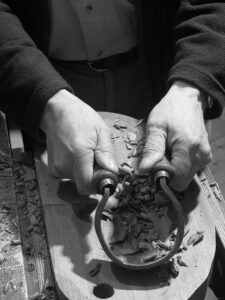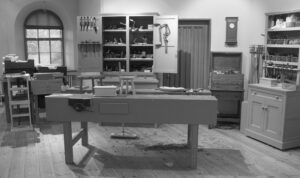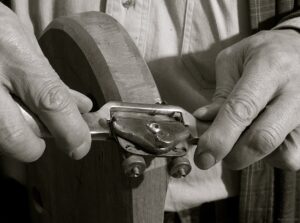Contributing to the Real Woodworking Campaign

Motivational writers
As a Fellow of the RSA, I just read the RSA Winter 2011 member magazine. High profile writers through the years have moved into the void left by workers of real material to tell craft artisans where the future lies based on their research and discussions around the conference tables of the various global zones. Clever words and phrases have somehow replaced the doing of work in the same way writers writing about woodwork tell working craftsmen how they should work, with what, when and where. This kind of unchallenged input, then defines the culture itself so that we buy and sell and move our businesses, schools and strategies to line up with how they perceive we should be doing work. Saw makers in Sheffield and in other places tell us which saws we should use and how much we should pay. Engineers write books on issues surrounding our craft and we, unconsciously for the main part, drift into adopting what they present as truths without seriously examining the past, present and future. We then throw away sound practices only to readopt them five decades later.
Contributors
I saw something Robin Wood (Heritage Crafts Association) found about a clog maker from Sweden some time back. Old film footage where a man used an axe and some oversized spoon augers to shape a pair of clogs from two sticks of firewood. It was both inspiring and very informing, but more than that it was conservation in action. A great archive for working wood in real ways.

Writing for the Real Woodworking Campaign

Content can be on any woodworking issue from plane irons to pressed fibreboard and mass-making machines to how to cut dovetails or apprentice a young worker. It can be pages long or a paragraph or two. That’s all up to you.
Filling the void
Let’s not leave a void that only academics and politicians can fill. There’s a place for both that will create a more balanced perspective to help us make a more balanced assessment that influences the future of craft as a working culture.


Hi Paul,
I was not sure where the introduction was going, as a fellow of the RSA do you see them as a talking shop for high profile writers and academics? I am not a fellow, can’t justify the £150 a year on my income, do you find it to be worth it? I did recently have an excellent meeting with Mathew Taylor the CEO alerting him to some of the issues facing the world of craft and he is one of the most dynamic folk I have met, time will tell if anything comes of it. Glad you enjoyed the clogmaker, we owe a debt not only to the craftspeople that developed and passed on skills to us but also to some of those early film makers that recorded gems like that. My personal all time favourite is César’s bark canoe, available online here. http://www.nfb.ca/film/Cesars_Bark_Canoe
I think the price is steep, prohibitive really. I hope that it will give me a voice when I think there is something to say of value that will balance existing perspectives or make necessary changes. I think there is a case for persuasive speakers but not from exclusivity nor from orators and writers only. That’s why I am there.
What is “real” woodwork then?
We know a lot of people indulge in imaginary wwork i.e. have the tools (often very posh ones) and gadgets but don’t produce a lot, but isn’t what you mean, I guess.
Yes, it’s more about getting your hands on the real wood with real tools and discovering the actual cells, cellulose, lignin and the stuff of wood with all of its knots and and fibres in as near an organic condition as possible rather than the reconstituted pulverised stuff that back in the seventies they told us carpenters and joiners we could make mortise and tenon joints from and it would look and last like wood only better.
It’s all about discovering real joints without digestive biscuits that are hard to stomach and totally unnecessary add-ons to tabletop edge joints for instance, or splitting and riving a tree to make a Clisset chair or a others ranging from post-and-rung to Windsors and Craftsman-style to Shaker. Beyond my finite mind there are thousands of other serious people, woodworkers, who can and will contribute articles that will help define this objective. We are looking at a long term objective that will preserve and conserve woodworking that will be run by woodworkers for woodworkers. people that care about crafts skill, real wood, work ethic, workmanship and such like that.
Thanks for asking.
There are many frayed edges to this reasoning. One is that the writer thinks it’s snobbery to oppose machine methods when no one actually said that we shouldn’t use machines to make joints.
Two, if a machine cuts the joint, you didn’t do it the machine did, so one is woodworking and the other is wood machining. And there is nothing wrong with that except some aspects of machining are boring at best and slower than hand methods in some cases.
Three, you don’t need skill to work a machine. Just common sense and safety training.
Four, 90% of dovetail joints are hidden for 90% of their life. That’s not really true at all if they are through or common dovetails they are highly visible all of the time. When they are half-lap or lap dovetails its an important feature whether seen or not.
Five, machine cut joints are fine. They are just not hand cut.
Six, no one asked anyone to go cut down a tree to pitsaw a log.
Seven, no one made a big fuss about anything. We simply presented another alternative and we can all talk about it as much or as little as we want to.
There is of course a lot more going on here and I would like to hear from other people who have interest in bringing balance into this equation.
To me the main issue is loss of skills. The skill set for woodworking evolved over centuries across the world. Whether they did things the same way or not, you see similar joints from all over history and geography.
Now, because so many people have come to believe that only machines can do such work, they are amazed that those past woodworkers were able to do it by hand. When they try to do the same things, because they aren’t used to the effort required to develop a skill, they give up too easily.
Using machines is a double-edged sword in that they provide a force multiplication benefit (I can get a lot more lumber dimensioned in a day with machines than with hand tools), yet they cause the hand skills to grow rusty and be forgotten.
Is it worth preserving skills just for the sake of preserving skills? I think so, even though that may not have much practical benefit. I do think it’s worth preserving them for those times when machine work isn’t practical. There are situations where you want to get work done, but the machines aren’t available.
I personally find working with hand tools to be much more enjoyable. That’s purely a personal choice, and might not make sense for others. But because I was so focused on machine work for so long, I did not have the hand tool skills, so I missed out on a lot of enjoyment. Had those skills died out completely, I never would have known that pleasure.
Loss of skills due to over-reliance on machines is a problem in other endeavors, not just woodworking. It’s not always clear why we might want to keep those skills around, but I think it’s worth maintaining them as a long term backup plan. There are times when you have to fall back on them.
Great balance there. Like it.
Very balanced perspective coming in here again. Great for the RWC.
I think, being an amateur, that woodworking handskills, techniques and tools are heritage of the past and the only way to preserve them is to use and teach them, much like taking care of an antique piece. Most people who buy furniture are not interested in the making, whether its hand or machine made or whether the craftsmen struck the right balance between hand and machine use. They just want to enjoy and use that piece.
In my view hand tools offer an intimate relationship with the object, be it wood, metal etc and it is mostly for the joy and personal satisfaction of the craftsmen and only under lucky circumstances the buyer.
Hand tool working nowadays can be viewed as a form of art or craft therapy, it is a form a reparation I believe.
But machines won’t do.
Just imagine a painter using a drawing program and making a printout. Is it the same as a traditional hand painted picture?
Machines offer speed, reproducibility, but place a barrier between the maker and the product so its no longer a personal expression. Using an old tool places you back in time, it is a journey within and there you have the result.
Thats how I see RWC.
Thanks.
Norbert